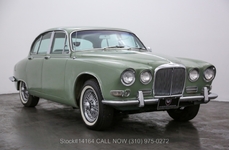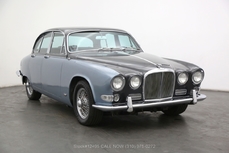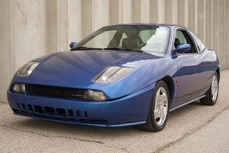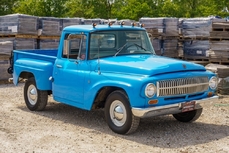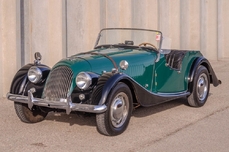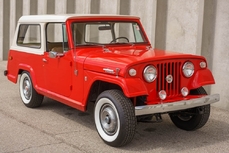Jaguar 420 Inline 6 1967
General description :
1967 Jaguar 420Sedan
Previous owner had the Jaguar for over 42 years and bought the car from the original owner
Original owner was a Hollywood producer and founder of the pioneer surfing outfitter, Laguna Sportswear
Genuine California black plate that was issued on the car in 1975
From the personal collection of the Astor Classics Museum
Original numbers matching engine and transmission
89,514 actual miles backed by documentation over the years
One of 5,839 Jaguars exported to the United States in 1967
Honey Beige exterior and tan interior
4.2L DOHC inline six-cylinder engine with two HD8 SU carburetors
Borg-Warner Model 8 three-speed automatic transmission
Factory Delanair air-conditioning
Marles Varamatic power steering, power four-wheel disc brakes
Wire knock off wheels and independent suspension
Motorola FM106M solid-state AM/FM/SW radio
Documentation includes the original operators manual, original periodic service handbook, original maintenance voucher, original Delanair air-conditioning connection instructions, original radio service guide, original car radio service book, original dealer book and assorted other insurance and licensing paperwork
Taking elements from the S-Type sedan and the E-Type Coupes, Jaguar plucked the best of both to create its 420 Sedan. MotoeXotica Classic Cars is pleased to offer this genuine black plate California example that has fabulous ownership history. This 1967 Jaguar 420 loaded with factory air conditioning was bought new at Brentwood Motors Jaguar Dealership on November 2nd 1967, which was located in Santa Monica, California to the founder of one of the local pioneering surf clothing outfitters, Laguna Sportswear. In 1975 the producer/surf outfitter sold the Jaguar to his radio station friend Arthur Astor of Santa Ana California.Art Astor is the owner of radio stations KCEO, KSPA in the Inland Empire and KFSD in San Diego, he is a 50-year veteran of Southern California broadcasting. In addition over the past 30 years Astor had assembled a truly spectacular stable of vintage automobiles, over 250 low-mileage examples spanning the 1920s to the 1970s and this 1967 Jaguar was one of the first additions to Astor’s amazing car collection. Please note that we also have the 1957 Jaguar XK140 FHC for sale from Astor’s fine collection!
Dressed in correct Honey Beige, this cars paint and trim are in overall very good order; the windows are clear and intact. The cars lights are clear, intact and lend the car part of its style and grace.
This cat rolls on radial tires, sized 205/75R15 and are topped with factory wire wheels. Both the tires and wheels are in decent condition. All of the cars body panels are straight and solid and the bumpers are in very good order.
Under the tilt-up bonnet (hood) is Jaguars 4.2L DOHC inline six-cylinder (numbers matching #7F3804-9) with two HD8 SU carburetors and mated to a Borg-Warner Model 8 three-speed automatic transmission (numbers matching #16849). Driver convenience features included factory Delanair air-conditioning, Marles Varamatic power steering, power four-wheel disc brakes and independent suspension.
Inside, the tan interior is overall very fine shape. The Connolly Leather seats look fantastic as does the complementing Wilton wool carpet and the supple headliner. The instrument panel with its full set of gauges and burled walnut accents is in crack-free and still looks very good. The original, two-spoke black steering wheel is in very good condition, as are the inner door panels, with burled window frames that echo the dashboard accent. The mirror glass and shift lever are in good condition. Finishing off the interior is a Motorola AM/FM/SW solid-state radio.
Documentation includes the original operators manual, copy of the 1975 California title with the registration of the VVN-785 black plate that is still on the car today, original periodic service handbook, original maintenance voucher, original Delanair air-conditioning connection instructions, original radio service guide, original car radio service book, original dealer book and assorted other insurance and licensing paperwork.
Competition to this Jaguar in 1967 included Bentleys T, Cadillacs Sedan de Ville, Lincolns Continental Sedan and Mercedes-Benz 300SEL.
Documentation includes original owners manual and assorted documents.
This car is currently located at our facility in St. Louis, Missouri. Current mileage on the odometer shows 89,514 miles. It is sold as is, where is, on a clean and clear, mileage exempt title. GET OUT AND DRIVE!!!
VIN: J67P1F26124BW EIN: 7F3804-9 TIN: 16849
http://www.motoexotica.com/inventory/listing/1967-jaguar-420-sedan/
1967 Jaguar 420 Inline 6 is listed sold on ClassicDigest in Fenton (St. Louis) by for Not priced.
Car Facts
Car type : Car Make : Jaguar Model : 420 Model Version : Inline 6 Engine size : 0.0 Model Year : 1967 Sub type : Sedan Location : Fenton (St. Louis)
Sold
Seller Information
Sold
People who viewed this Jaguar 420 also viewed similar Jaguar listed at ClassicDigest
Other cars listed for sale by this dealer
About Jaguar
Ah, the story of Jaguar, from its early days as the SS Cars Ltd. to its pinnacle with the D-type, and the street-going evolution in the form of the iconic E-type. There's something quintessentially British about this tale, and I'll narrate it as a British journalist might.In the Beginnings:
Our journey into the world of Jaguar begins in the 1930s, when a company known as SS Cars Ltd. emerged. Despite the unfortunate coincidence of their initials with the rising political tensions in Europe, they started producing stylish and performance-oriented cars. The SS 100, introduced in 1936, was a symbol of elegance and speed, setting the stage for what would become Jaguar.
The Birth of Jaguar:
As the shadows of World War II loomed, SS Cars Ltd. wisely decided to disassociate themselves from the SS initials. Thus, in 1945, they officially became Jaguar Cars Ltd., a name that would soon be synonymous with British luxury and performance.
The XK Series:
Jaguar's post-war era brought us the XK 120, a true sensation in 1948. With its sleek design and a powerful 3.4-liter inline-six engine, it became the world's fastest production car. The XK 120 was the blueprint for what lay ahead – Jaguars that blended style with speed in a uniquely British fashion.
The D-type Dominance:
Then came the D-type, a true racing legend. Introduced in 1954, it won Le Mans three times in the 1950s, showcasing Jaguar's engineering prowess. With its innovative monocoque construction and the iconic fin at the back, the D-type was the apex of Jaguar's motorsport success.
The E-type Emergence:
But the true turning point arrived in 1961 with the introduction of the E-type, often described by Enzo Ferrari as "the most beautiful car ever made." Its long bonnet, curvaceous body, and a 3.8-liter engine delivering exhilarating performance made it an instant classic. The E-type was not just a car; it was a work of art on wheels, and it could hit 150 mph on the road.
Street and Racing Success:
The E-type's beauty was matched by its capability on the track. The lightweight E-types were particularly successful in various racing events, cementing Jaguar's reputation as a force to be reckoned with in motorsport.
The Age of Refinement:
As we delve deeper into the Jaguar story, we find that the 1950s and 1960s were an age of refinement and expansion. Alongside the magnificent D-type and the E-type's iconic emergence, Jaguar introduced models that further solidified its reputation for luxury and performance.
The MK2:
In the late 1950s, Jaguar unveiled the MK2, a sports sedan that combined elegance with power. This sleek four-door saloon was a favorite of bank robbers and law enforcement alike, thanks to its exceptional speed and handling. The MK2 was a symbol of Jaguar's ability to blend sophistication with performance and had a successful racing career as well.
The XJ6:
Fast forward to 1968, and Jaguar launched a car that would define luxury saloons for decades to come – the XJ6. It was a masterpiece of engineering and design, featuring a smooth inline-six engine, independent rear suspension, and a spacious, beautifully appointed interior. The XJ6 was a symbol of British elegance and provided a ride so smooth that it seemed to glide over the road. It became the flagship model for Jaguar and set the standard for luxury saloons, showcasing a level of refinement that left competitors in awe.
The Blend of Classic and Modern:
While the MK2 and XJ6 represented the evolution of Jaguar's saloon cars, they maintained the brand's commitment to performance and luxury. These cars didn't just belong on the racetrack; they were equally at home cruising down the grand boulevards or gliding through the English countryside.
The Challenges of Change:
However, as the 1970s arrived, Jaguar, like many British automakers, faced financial challenges and changes in ownership. The British Leyland era brought both opportunities and struggles, as the brand navigated through various mergers and transitions.
Nevertheless, the legacy of the MK2 and XJ6, along with the D-type and E-type, continues to define Jaguar as a manufacturer that combines timeless elegance with a spirit of performance. These classic models, whether driven on winding roads or parked as collectors' treasures, serve as a testament to Jaguar's enduring presence in the world of automotive excellence.
The Jaguar story, from its early days as SS Cars Ltd. to the creation of automotive icons like the E-type, MK2, and XJ6, is a journey that reflects the very essence of British motoring – a blend of luxury, power, and style that continues to captivate enthusiasts and connoisseurs alike.



